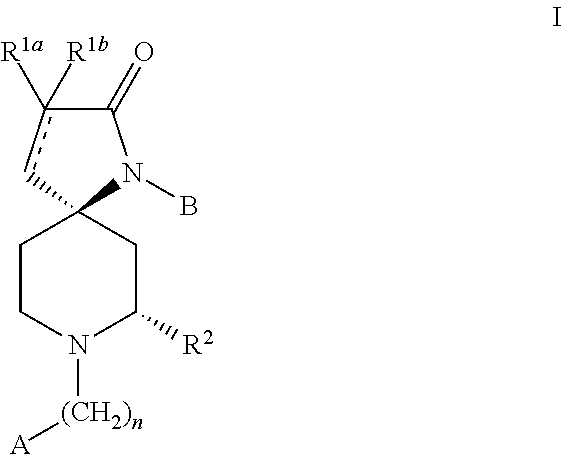Novel Lactams as Beta Secretase Inhibitors
a beta secretase inhibitor and lactam technology, applied in the field of alzheimer's disease and other neurodegenerative and/or neurological disorders, can solve the problems of no effective treatment for halting, preventing, or reversing the progression of alzheimer's disease, and achieves the effects of reducing the risk of alzheimer's disease progression, and reducing the risk of alzheimer's diseas
- Summary
- Abstract
- Description
- Claims
- Application Information
AI Technical Summary
Benefits of technology
Problems solved by technology
Method used
Image
Examples
preparation 1
Racemic (5R,7S),(5S,7R)˜1˜(3˜fluorophenyl)˜7˜methyl˜1,8˜diazaspiro[4.5]dec˜3-en-2-one (P1)
[0135]Step 1. Synthesis of benzyl 2˜methyl˜4˜oxo˜3,4˜dihydropyridine˜1(2H)˜carboxylate (C1). Benzyl chloroformate (235 g, 1.38 mol) was added drop-wise to a chilled solution of 4-methoxypyridine (150 g, 1.38 mol) and triethylamine (19 mL, 0.137 mol) in anhydrous tetrahydrofuran (6 L), while keeping the temperature below ˜50° C. A white precipitate formed. After completion of the addition, the resulting suspension was stirred at −60° C. for 20 minutes. Methylmagnesium bromide (3.0 M in diethyl ether, 650 mL, 1.95 mol) was then added drop˜wise at ˜60° C.˜˜50° C. The reaction mixture was stirred at room temperature overnight, at which time thin layer chromatography (petroleum ether / ethyl acetate=1:1) indicated that the reaction was complete. After quenching the reaction with 1 N aqueous hydrochloric acid (500 mL), the color of the reaction mixture became brown˜black. The organic layer was separate...
preparation 2
Racemic (5R,7S)(5S,7R)˜1˜(3˜fluorophenyl˜7˜methyl˜1,8˜diazaspiro[4.5]decan-2-one (P2)
[0145]
[0146]Synthesis of P2. A mixture of C9 (20 g, 51 mmol) and palladium hydroxide on carbon (2 g) in methanol (200 mL) was stirred under 45 psi of hydrogen at room temperature for 18 hours. Thin layer chromatography (petroleum ether / ethyl acetate=2:1 and dichloromethane / methanol=10:1) showed the reaction was complete. The reaction mixture was filtered and the filtrate was concentrated in vacuo: the residue was then diluted with ethyl acetate (100 mL) and water (100 mL). The mixture was cooled to 10° C. and acidified with 1 N aqueous hydrochloric acid to pH 2-3, after which the aqueous layer was separated and maintained at 10° C. It was then basified to pH 11 with saturated aqueous sodium hydroxide, and extracted with ethyl acetate (5×200 mL). These five organic layers were combined, dried over sodium sulfate and evaporated to give P2 as a red syrupy solid. Yield: 9.0 g, 34 mmol, 67%. LCMS m / z 263...
preparation 3
(5R,7S)˜1˜(3˜Fluorophenyl)˜7˜methyl˜1,8˜diazaspiro[4.5]dec˜3˜en˜2˜one (P3)
[0147]Step 1. Synthesis of benzyl (2S,4R)-4-cyano-4-[(3-fluorophenyl)amino]-2-methylpiperidine˜1˜carboxylate (C10). A solution of benzyl (2S)˜2˜methyl˜4˜oxopiperidine˜1˜carboxylate (see C. Coburn et al. PCT Patent Application Publication WO 2007011810 A1 20070125) (31 g, 125 mmol) in acetic acid (250 mL) was treated with 3-fluoroaniline (24.1 mL, 250 mmol) followed by zinc cyanide (36.8 g, 313 mmol). The reaction mixture was allowed to stir at room temperature for 18 hours, at which time it was cooled in an ice bath and slowly basified with aqueous ammonium hydroxide solution. The resulting mixture was extracted three times with dichloromethane, and the combined organic layers were dried and concentrated in vacuo. Purification of the residue by silica gel chromatography (Eluant: 20% to 40% ethyl acetate in heptane) afforded a mixture of C10 and its isomer benzyl (2S,4S)-4-cyano˜4˜[(3˜fluorophenyl)amino]˜2˜meth...
PUM
| Property | Measurement | Unit |
|---|---|---|
| temperature | aaaaa | aaaaa |
| temperature | aaaaa | aaaaa |
| temperature | aaaaa | aaaaa |
Abstract
Description
Claims
Application Information
 Login to View More
Login to View More - R&D
- Intellectual Property
- Life Sciences
- Materials
- Tech Scout
- Unparalleled Data Quality
- Higher Quality Content
- 60% Fewer Hallucinations
Browse by: Latest US Patents, China's latest patents, Technical Efficacy Thesaurus, Application Domain, Technology Topic, Popular Technical Reports.
© 2025 PatSnap. All rights reserved.Legal|Privacy policy|Modern Slavery Act Transparency Statement|Sitemap|About US| Contact US: help@patsnap.com



